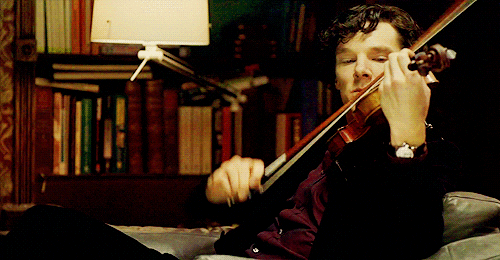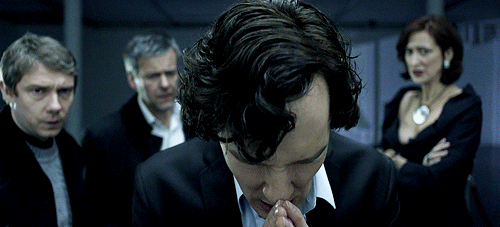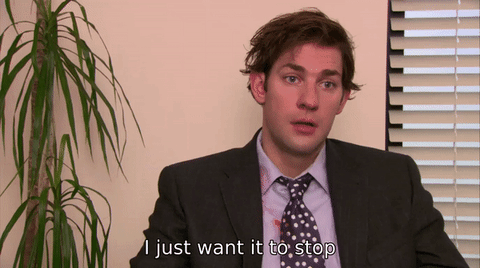Imagine this: You are Sherlock Holmes, immersed in a perplexing murder mystery on a cold London night. Clues are scarce, and the perpetrator is nowhere to be found – an enigma within an enigma. Intriguing. However, you find yourself at an impasse, devoid of solutions. You retreat to your cosy study and begin playing your violin. As the soothing music permeates the room, your thoughts start to wander away from the case’s specifics. Suddenly, it clicks – you’ve identified the murderer!🤯 Seen this occur in Sherlock before? Let’s delve into the fascinating world of focused versus diffuse thinking that makes this possible.

The Strings of the Violin: A Symphony of Diffuse Thinking in ‘The Hound of the Baskervilles’
The tale of ‘The Hound of Baskervilles,’ penned by Sir Arthur Conan Doyle, is steeped in local lore about a demonic hound haunting the Baskerville lineage, a curse purported to claim lives if they dare tread onto Dartmoor after sunset.
Our story then moves to Baskerville Hall, nestled within the ominous, treacherous moors of Devonshire. Here, Dr Watson finds himself safeguarding Sir Henry Baskerville. With Sherlock preoccupied in London, Watson becomes the observer, diligently relaying updates about the residents, happenings, and anything unusual.

Meanwhile, in the city, Sherlock navigates the maze of Watson’s reports. A complex mesh of questions and clues awaits untangling. After a gruelling day of detailed analysis, the trail runs cold. Holmes retreats to the comforting familiarity of his home and his cherished violin 🎻.
As Holmes infuses the silent room with his music, his mind starts to wander, shedding its intense focus on the case’s intricate puzzle. In this state of relaxation, he starts connecting seemingly unrelated dots.
Suddenly, like a bolt of lightning, he gains a flash of insight, and the mystery unravels itself.

What led to this breakthrough for Sherlock Holmes? He had tapped into the power of diffuse thinking.
I knew that seclusion and solitude were very necessary for my friend in those hours of intense mental concentration during which he weighed every particle of evidence, constructed alternative theories, balanced one against the other, and made up his mind as to which points were essential and which immaterial.
– Dr. Watson; The Hound of the Baskervilles
A Dual Dance: Focused vs. Diffuse Thinking
Understanding focused vs. diffuse thinking is like understanding the workings of a perfectly balanced dance. They are not opponents; instead, they are partners in the cognitive ballet of problem-solving.
🧐 Focused thinking resembles a microscope’s detailed scrutiny, helping us delve deep into specific issues. However, it sometimes restricts our perspective, narrowing our vision and ideas.
On the flip side, diffuse thinking😴 acts like a wide-angle lens, capturing a broader image, albeit with somewhat blurred details. When we engage in diffuse thinking, our minds roam freely, connecting unrelated information, and leading to inventive insights and solutions.

A bird, for example, needs to focus carefully so it can pick up tiny pieces of grain as it pecks the ground for food, and at the same time, it must scan the horizon for predators such as hawks…. If you watch birds, they’ll first peck, and then pause to scan the horizon—almost as if they are alternating between focused and diffuse modes.
Barbara Oakley
Two Sides of the Cognitive Coin: Beer Mode and Coffee Mode
David Perell eloquently dubs this as the ‘beer mode’ and ‘coffee mode’ of thinking in his article.
💡 ‘Beer mode’ is akin to a leisurely, playful state where novel ideas emerge. In contrast, ‘coffee mode’ is a state of high focus driving towards a specific outcome. Balancing these modes – the exploration of ‘beer mode’ and the action-driven ‘coffee mode’ – is like the rhythm of breathing.

Sherlock Holmes, in his violin-playing reverie, was practising diffuse thinking (or beer mode), allowing him to draw connections and solve the murder mystery after gathering the necessary facts.
Unravelling the Brain: The Neuroscience Behind Focused and Diffuse Thinking
Recent neuroscience research has lent credibility to the concepts of focused and diffuse thinking.
A research called ‘Improved learning in a large-enrollment physics class,’ talks about how focused thinking activates certain neural pathways in our brain, forming a clear route for information processing. The paper discusses how even in a large class, the positive effects of a tutor model can be achieved using evidence-based teaching methods which leads to a more focused approach to information processing.

Conversely, diffuse thinking seems to involve the default mode network (DMN), a part of the brain that comes into play when we’re not focusing on the outside world which is discussed in this research paper on ‘the brain’s default network‘. This network allows us to make broad connections, fostering creative problem-solving and innovation.
To the best of our scientific knowledge, you can’t be in both focused and diffuse modes at the same time. To make creative breakthroughs in your work, you need to oscillate between focused and diffuse mode, like a tennis ball.
Working Like A Lion, Not Like A Cow: Thoughts?
Naval Ravikant in his article ‘Work As Hard As You Can‘ asks us to work like a lion, not like a cow. What does that mean? 🤔
“The way people tend to work most effectively, especially in knowledge work, is to sprint as hard as they can while they feel inspired to work, and then rest. They take long breaks“, says Naval.
This is more like a lion hunting 🦁. You sprint and then you rest. You reassess and then you try again. Build a marathon of sprints.

Don’t work like a cow 🐮 grazing the field all day. Naval continues, “Nobody really works 80 hours a week. People who say they work 80-hour weeks or even 120-hour weeks, often are just status signalling. It’s showing off. Nobody really works 80 to 120 hours a week at high output, with mental clarity. Your brain breaks down. You won’t have good ideas.“
The idea relates to focused vs diffuse modes of thinking – when you have inspiration, you sprint and act on your inspiration. Once you have don’t that, reassess, relax, generate more ideas, and build inspiration. Build yourself for the next sprint.
If I’m inspired to write a blog post or publish a tweetstorm, I should do it right away. Otherwise, it’s not going to get out there. I won’t come back to it. Inspiration is a beautiful and powerful thing. When you have it, seize it.
Naval Ravikant
Mindfulness, Flow, and the Harmony of Thinking Modes
In focused vs. diffuse thinking, concepts like mindfulness and flow come to light. They borrow elements from both cognitive styles and strike a balance.
Mindfulness incorporates being present and aware, like focused thinking, yet also embraces non-judgmental acceptance of thoughts and feelings, similar to the diffuse mode.
Lawrence Yeo brilliantly explains the importance of reflection in his article on creating wisdom. Reflection must be purposeful – you have to set aside time to take a solo walk, you must block out your schedule to meditate, etc. Since it must be done with intention, it comes from a higher plane of rationality that can override the angst pervading an automated day.
By default, the door to the Gold Mine of Wisdom remains closed.
Most of the time, we’re too focused on fulfilling our daily responsibilities in the Mine of Everyday Events, and they tend to take precedence over our desire for clarity.
In order to open these doors, we must press pause on the incessant motion of daily life through the avenue of reflection.
Lawrence Yeo
Once you have reflected and have had a burst of inspiration (like Sherlock Holmes), you switch back to the focused mode, working on the inspiration. You could utilise the concept of “flow” when doing focused work.
Flow, a term brought to the mainstream by psychologist Mihaly Csikszentmihalyi in his book, symbolizes being ‘in the zone,’ absorbed in a task with a balanced challenge and skill level. This state mirrors a blend of both cognitive styles, concentrating on the task while allowing ideas to flow freely.

From Theory to Practice: Leveraging Focused and Diffuse Thinking
Understanding and applying the concept of focused vs. diffuse thinking can significantly boost your productivity and creativity. Here are ways to employ both in your daily life:
🧠 Alternate between modes: Utilize focused thinking for learning new concepts or analyzing intricate details. Switch to the diffuse mode for brainstorming or gaining a fresh perspective.
☕️ Breaks are beneficial: When faced with a challenging problem, work on it, then take a break and engage in a relaxing activity. This strategy, known as the Pomodoro Technique, involves focused and diffuse thinking.

🎵 Cultivate creativity: Activities like doodling, daydreaming, or playing a musical instrument stimulate diffuse thinking, encouraging creative insights.
🥦 Foster a healthy lifestyle: Regular exercise, a balanced diet, and sufficient sleep facilitates both focused and diffuse thinking (explained in this book).
📵 Turn off your phone: Doom scrolling is actually taxing your mind. When you pick up your phone in between work to “take a break” or “relax”, you’re not actually taking a break or relaxing. You’re taking in inputs which trigger thoughts that put you in focus mode consequently affecting your mood. If you actually want to take a break or relax, let yourself be bored, and sit alone quietly.
All of humanity’s problems stem from man’s inability to sit quietly in a room alone.
Blaise Pascal
The Mirage of Unending Focus: Questioning the Productivity Influencers
The issue with a lot of content online these days is the focus on how to increase productivity and be more efficient.
All of the tweets, articles, and videos are talking about the focused mode of thinking. If you are spending all day trying to actively focus on solving a problem, you are just loading your mind with complexity and not giving it time to process it. It’s a mirage of unending focus. And it’s tiring.

But have you ever been stuck trying to solve a problem and decide to take a shower?🚿 You most likely find the solution. Most probably this is what happened to Archimedes!💡
When you enter the diffuse mode of thinking your thoughts wander and explore, connecting disparate dots and illuminating novel insights. And this bit is the key!
You cannot be in a constant state of productivity as often preached by productivity influencers.
🧠 You need to oscillate between focused and diffuse mode to do complete work and generate ideas, or coffee mode and beer mode to get things done and relax a bit, or working like a lion and a cow to work on your inspiration and be inspired. They are all one and the same.
Think Days: Harnessing Diffuse Thinking for Innovation
A fantastic practice that can help you to intentionally incorporate diffuse thinking into your schedule is Sahil Bloom’s concept of “The Think Day”. This idea draws from Microsoft founder Bill Gates’ annual tradition, “Think Week.”
Think Week is a time when I can be creative and push my own thinking. It’s a time to step outside the day-to-day demands of my job and really focus on the big picture.
Bill Gates
Think Day is the process of regularly forcing free time into your schedule. Pick one day each month to step back from all your day-to-day professional demands.
✅ The ground rules:
- Seclude yourself (mentally or physically).
- Shut off all of your notifications on your devices.
- Put up an out-of-office response.
The goal is to spend the entire day reading, learning, journaling, and thinking. Move slow to move fast.
Sherlock’s Secret and Your Success: Focused vs. Diffuse Thinking
From Sherlock Holmes’ violin-led daydreams to groundbreaking solutions in science and art, the interplay between focused and diffuse thinking shapes our cognitive world. These thinking modes provide us with a toolbox for problem-solving, innovation, and unravelling the mysteries of life, much like Holmes alternating between coffee and beer modes to crack challenging cases.
The intuitive mind is a sacred gift, and the rational mind is a faithful servant. We have created a society that honours the servant and has forgotten the gift.
Albert Einstein




